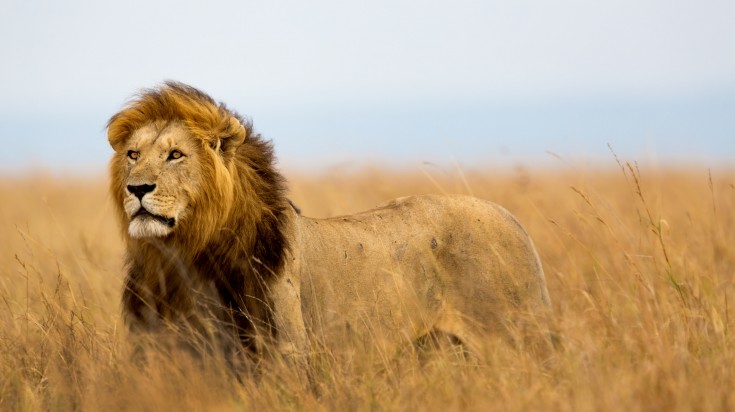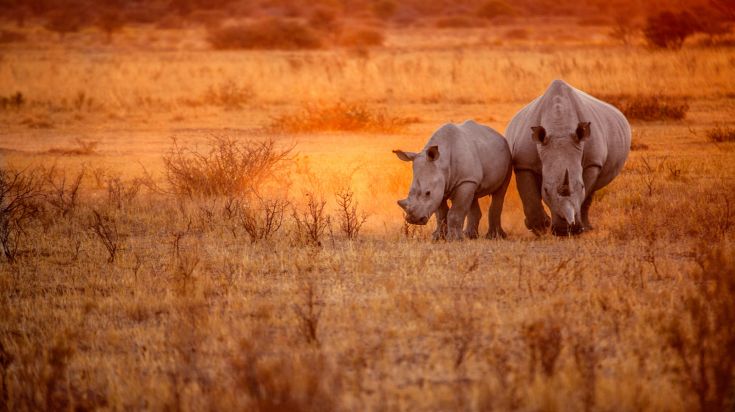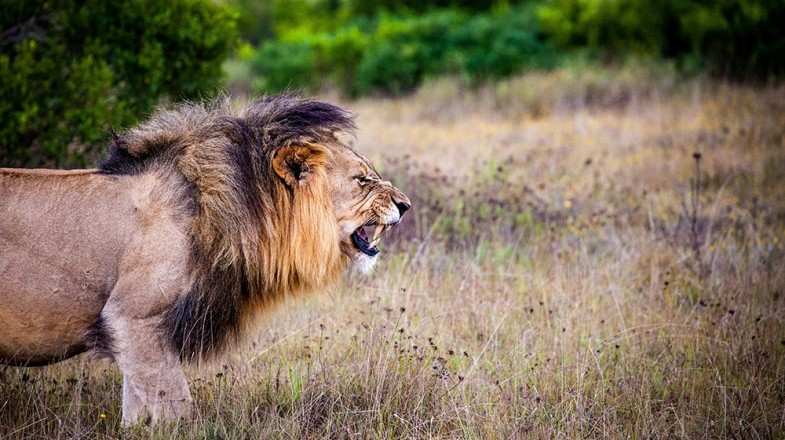The Big 5: Everything You Need to Know
The Big 5 refers to five African game animals: the African lion, the African leopard, the African elephant, the Cape buffalo, and the rhinoceros. These animals were originally called the Big 5 not for their size, but for the level of difficulty and danger big-game hunters faced when tracking and hunting these animals on foot. Bringing down one of these big five animals won the hunter a trophy, therefore making them the most sought-after African animals in the big-game hunting world.
Over one hundred years ago, these five animals were abundant. American president Theodore Roosevelt himself embarked on an African hunting expedition and was quoted as saying the “African elephant would never become extinct” due to the sheer number he encountered. Flash forward to the current day and most of the Big 5 animals are currently listed as “vulnerable” or “endangered” species. Although hunting of all these animals is still allowed to some degree, Africa has put strict laws in place to protect and conserve each species. However, poaching has been and continues to be a concern.
Nowadays, African safari operators and local hunting guides borrow the term Big 5 when marketing their tours and services. Visitors and big-game hunters who come to these African reserves will experience what it’s like to see these regal and majestic animals in the wild on their massive reserves or even experience the thrill of hunting one. In either case, it’s an accomplishment that is on many traveler’s bucket list.
- Mark Bromley
- From USA
Exploring each of the Big 5
Each of the Big 5 animals has a unique story and individual characteristics and behaviors. Below we consider each of the Big 5:
1. African lion

Known as the "King of the Jungle”, the African lion is the second largest cat in the world. In contrast to its nickname, lions reside in grassy, open savannahs, not in dense vegetation. The lion is one of the most sought-after trophies of all the Big 5 game animals. Lions are social creatures and live together in groups called prides of up to 30 lions. Lions in each pride look after one another and use their roar as a means of communication. A lion’s roar can be heard up to 5 miles away! There are estimated to be less than 20,000 lions left in the world, and the International Union for Conservation of Nature (IUCN) has listed them as ‘vulnerable’.
2. African leopard

As the most elusive of the Big 5 animals, a sighting of an African leopard is considered to be very special. Their preferred environment is rocky landscapes with dense brush and forests. However, leopards are known to be very adaptive creatures and are also spotted elsewhere. Leopards come out at night to hunt, and spend their days resting in the safety of tree branches, which they use as their lofted homes. Listed as ‘vulnerable’ by the IUCN, the leopard’s only real predators are humans.
3. African elephant

While the African elephant is the largest animal on this list as well as the largest land animal on earth, unfortunately, it also the most highly threatened by poachers who deal in the illegal ivory business. Elephants are native to 37 African countries with a current world population of 415,000. Sadly, 8% of elephants are poached every year. Like leopards, the only predators of the African elephant are humans. Global climate change is also becoming a threat as the savannahs African elephants call home are becoming increasingly hotter and drier, making survival more difficult. The IUCN lists them as ‘vulnerable’.
4. Cape buffalo

Usually considered the most dangerous of the five to hunt due to its unpredictable behavior, the Cape buffalo is nicknamed “Black Death” and the “Widowmaker”. The Cape buffalo has few predators, namely humans and lions, and will fiercely defend itself if threatened. They are sometimes reported as killing more humans than animals. The Cape buffalo is also the most plentiful and is not on any threatened, vulnerable, or endangered list. Their current population is 900,000, with 4 different sub-species, and 75% of the population exists in protected reserves.
5. Rhinoceros

The African rhinoceros is divided into two species; the Black Rhino and the White Rhino. White Rhinos live predominantly in South Africa but have been reintroduced to several other nearby countries. Ninety-eight percent of Black Rhinos live in four countries: South Africa, Namibia, Zimbabwe, and Kenya. Like lions, Rhinos live in grasslands, but also open savannahs. Rhinos are incredibly strong and thick animals, though surprisingly they can reach speeds of up to 30 miles per hour! There are only 29,500 Rhinos left on earth, with 70% of them living in South Africa, and hence are listed as ‘critically endangered’ by the IUCN.
Where to see the Big Five
There are thirteen countries where all five animals can be spotted. These are: Angola, Botswana, Uganda, Zambia, Ethiopia, Namibia, South Africa, Kenya, Zimbabwe, Tanzania, Rwanda, Malawi, and the Democratic Republic of Congo. Amongst them, we give you the 5 most dependable countries to see all five.
Visit the Serengeti National Park and Ngorongoro Conservation Crater in Tanzania for an intense experience and a densely packed park full of wildlife, including the Big 5. In fact, the Ngorongoro Crater is one of the few destinations where you witness all Big 5 in a single day. The fact that it is located inside a 300 square-meter crater makes for an amazing sight in itself!
Botswana, particularly the Chobe National Park and Okavango Delta, is another safari destination that can assure a big 5 sighting. Here you will likely see 4 out of 5 of the big five animals – the only one you may struggle to spot is the Rhino.
In Kenya, the cost of a Big 5 safari is relatively cheaper than the other four countries. Try Masai Mara, Lake Nakuru, Ol Pejeta Conservancy, or Lewa Wilderness Conservancy; these four parks still have a relatively large population of rhinos, which increases your chances of seeing all Five.
Etosha National Park in Namibia is the best option to see 4 out of the Big 5 animals. Unfortunately, this park is not home to cape buffaloes. It is, however, the best place in Africa to see the black rhino.

South Africa has been one of the most reliable African countries to spot all the Big 5 for a long time. Kruger National Park, one of South Africa's national parks is home to all Big 5 animals, and while it is easily accessible and affordable, it is also very well-managed. The Sabi Sands Private Game Reserve and Madikwe Private Game Reserve, which border Kruger, are both excellent options for a Big 5 sighting.
Good to Know
- You can volunteer for the conservation of the Big 5 animals. There are multiple places (especially in South Africa) where these opportunities can be found. Duties include monitoring and assembling data, as well as physical efforts such as fence patrols, removal of alien plants, and trash clean-up.
- It may sound counter-intuitive, but the fees paid by the big-game hunters that allow them to pursue the Big 5 animals goes towards that animal’s conservation efforts.
- The rhino became the most endangered species of the Big 5 largely in part to the demand for its horn. Poachers use many illegal methods to take these animals down including drugs, poison, and high caliber weapons.
- Poaching of wild animals is on the rise all over Africa.
- The biggest threat to the Big 5 is not sport hunting, but rather climate change and loss of habitat due to cultivation, ranching, fencing, mining, and construction of roads.
- National Geographic’s Big Cat Initiative aims to protect lions through the support of hundreds of conservation efforts, as well as aiding in the education of African teachers, conservationists, and women’s groups.
- In 1990, South Africa honored the beauty and importance of each one of the Big 5 animals by putting one on each of their bills.
The Big 5 are a celebrated bunch. They capture the attention of people from all ranges of the spectrum; travelers, tourists, locals, animal-lovers, and sport hunters alike flock to the continent in hopes of catching a glimpse of these rare and enchanting animals. Would you dare to come face to face with one of these beautiful beasts?




